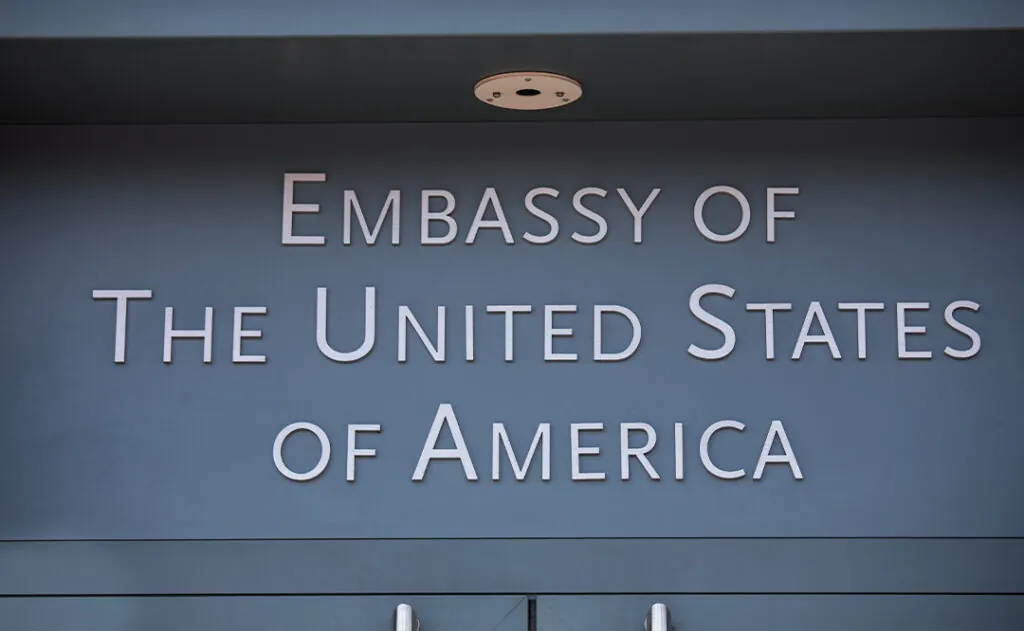You’re packing up your bag after the trip of a lifetime, exhausted and ready to return home when—uh oh. Your passport is missing.
While this sounds like a nightmare scenario, there are measures in place to help you get your documents replaced even when you’re far from home.
How to Report a Lost or Stolen Passport Abroad
The first step is to report your lost or stolen passport to the nearest U.S. embassy or consulate. Ask to speak with the Consular Section—they will be able to take your report and guide you through the process of obtaining a new passport.
Locating The Nearest Embassy or Consulate

The State Department hosts a directory of U.S. embassies and consulates. Take a screenshot of the address of the embassy closest to your accommodations before your trip in case WiFi is spotty. In a pinch, ask the front desk at your hotel for directions.
What Documents Do You Need to Replace Your Passport?
To replace a lost passport, applicants must fill out a form explaining the loss or theft of the passport (Form DS-64) along with the standard U.S. passport application form (Form DS-11).
Beyond that, the process is the same as a typical renewal application, requiring travelers to submit evidence of U.S. citizenship (and a photocopy), a photo I.D. (and a photocopy), an eligible passport photo, and the required fees.
When Will I Receive My Replacement Passport?
With expedited service (and the accompanying $60 fee), travelers can expect to receive their new passports in two to three weeks. Otherwise, expect a six to eight week wait.
Since most travelers aren’t prepared to add an extra month to their travel plans, embassies and consulates can issue emergency passports——”limited-validity” passports that can be issued as quickly as same-day. Once home, travelers can exchange their emergency passport for a full-validity replacement.
How Much Does It Cost to Replace a Lost or Stolen Passport?
The standard $130 renewal fee applies when replacing a lost or stolen passport, regardless of whether it is full or limited validity. The fee may be waived in extenuating circumstances, outlined by the State Department as:
- “the applicant is the victim of a serious crime; or
- the applicant is a victim of a disaster;
- and the applicant does not have and cannot reasonably be expected to obtain money to pay the fees before continuing travel.”
In such cases, the fees will be due when the passport holder exchanges their emergency passport.
How to Make Replacing a Lost or Stolen Passport Easier
The best strategy is to prevent the loss in the first place. Always check the safe in your hotel room before checking out or airplane seatback pockets before disembarking to ensure no crucial items are left behind. Invest in an anti-theft bag, like this one from Pacsafe, for extra security.
If the worst-case scenario arises, it helps to prepare ahead of time. Bring along photocopies of your important documents, including your original passport, as well as an extra passport-approved photo. Program the number of your nearest consulate or embassy into your phone and keep the address handy by dropping a pin in your Maps app before departure.
FAQ
Are there fees for losing your passport?
No, there are no additional fees for a lost passport beyond the typical cost of renewing a passport.
I found my lost passport after reporting it lost or stolen. Can I still use it?
Unfortunately, once a passport is reported lost or stolen, it is no longer valid.
Can I apply for an emergency passport online?
No. You must apply in person at the embassy or consulate for an emergency passport.
Are emergency passports biometric?
Emergency passports are not biometric, meaning they lack the electronic chip containing a digital copy of the passport holder’s information that is present in standard U.S. passports.
Can I travel anywhere with an emergency passport?
Due to the lack of biometric function, some countries may not accept a U.S. emergency passport for entry.
You Might Also Like:
• The Best and Worst Rental Car Companies in North America• 10 Quintessential Fall Weekend Trips
• The 8 Scariest Haunted Hotels in the World
• Your Questions About Online Passport Renewal, Answered
• How To Skip To The Front Of The Airport Security Line…Every Time
We hand-pick everything we recommend and select items through testing and reviews. Some products are sent to us free of charge with no incentive to offer a favorable review. We offer our unbiased opinions and do not accept compensation to review products. All items are in stock and prices are accurate at the time of publication. If you buy something through our links, we may earn a commission.
Related
Top Fares From
Today's Top Travel Deals
Brought to you by ShermansTravel
Ireland: 9-Night Dublin, Kilkenny, Killarney, Galway...
Brendan Vacations
 vacation
$3875+
vacation
$3875+
Amsterdam to Copenhagen: Luxe, 18-Night Northern...
Regent Seven Seas Cruises



Ohio: Daily Car Rentals from Cincinnati
85OFF.com






